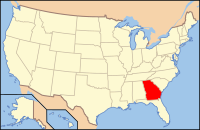Lumpkin County, GA
| Lumpkin County, Georgia | |
|---|---|

Lumpkin County Courthouse in Dahlonega
|
|
 Location in the U.S. state of Georgia |
|
 Georgia's location in the U.S. |
|
| Founded | December 3, 1832 |
| Named for | Wilson Lumpkin |
| Seat | Dahlonega |
| Largest city | Dahlonega |
| Area | |
| • Total | 284 sq mi (736 km2) |
| • Land | 283 sq mi (733 km2) |
| • Water | 1.3 sq mi (3 km2), 0.4% |
| Population (est.) | |
| • (2015) | 31,408 |
| • Density | 106/sq mi (41/km²) |
| Congressional district | 9th |
| Time zone | Eastern: UTC-5/-4 |
| Website | www |
Lumpkin County is a county located in the north central portion of the U.S. state of Georgia. As of the 2010 census, the population was 29,966. Its county seat is Dahlonega.
This area was settled by the Cherokee, who also occupied areas of what became delimited as southeastern Tennessee and western North Carolina.
Lumpkin County was created on December 3, 1832. The county was named for Wilson Lumpkin, who at the time was governor of Georgia. Lumpkin's daughter, Martha Wilson Lumpkin Compton, was the namesake of the town named Marthasville, the early-1840s name for Atlanta in Fulton County; this was designated as the capital of the state after the Civil War.
In the 1830s gold was discovered in the county near Auraria in the 1830s, leading to a rush of miners and development. The U.S. government established a mint in Dahlonega. It was operated for more than 20 years, until the Civil War broke out. State contractors later acquired gold from this county to gild the dome of the current state capitol building in Atlanta.
Agriculture and agritourism are top business industries. In addition, vineyards have been developed here and, since the mid-1990s, Lumpkin County has been recognized as "the heart of Georgia wine country." The county features several vineyards and five licensed wineries, which attract many tourists. In 2015, state senator Steve Gooch introduced Georgia Senate Resolution 125, officially recognizing Lumpkin County as the Wine Tasting Room Capital of Georgia.
...
Wikipedia
